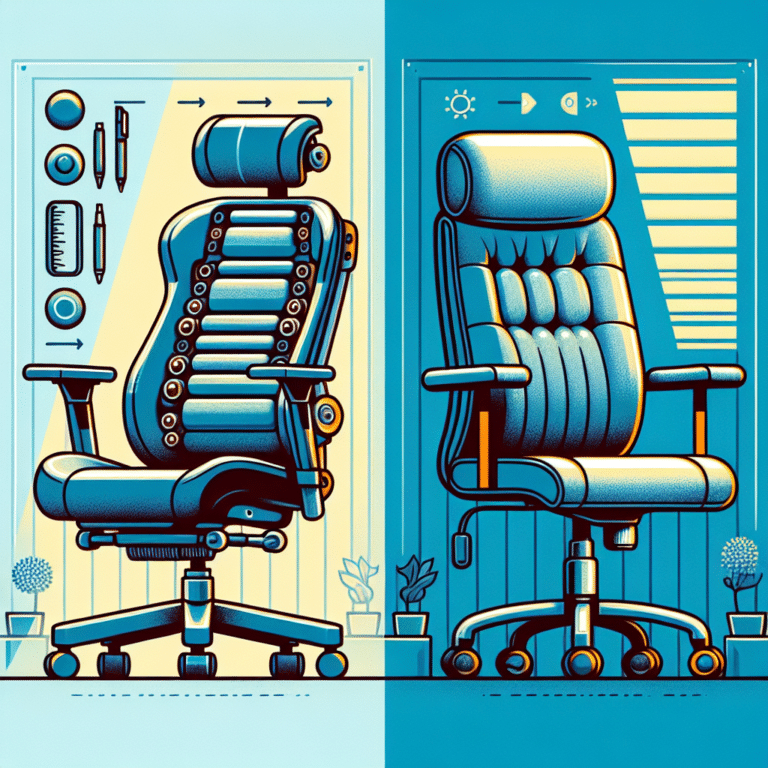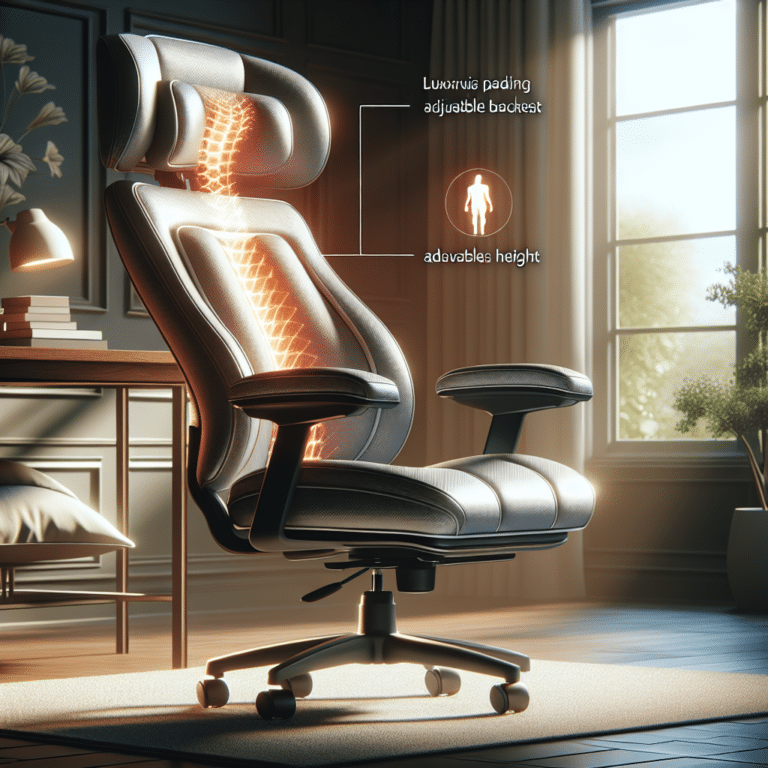Is An Ergonomic Chair Right For You? A Comprehensive Guide
Is sitting at your desk for long hours causing you discomfort and back pain? If so, it may be time to consider investing in an ergonomic chair. In this comprehensive guide, we will explore the benefits of ergonomic chairs, explain what makes them different from traditional office chairs, and provide tips on how to choose the perfect ergonomic chair for your needs. Say goodbye to discomfort and hello to improved productivity and comfort in the workplace.
Understanding Ergonomics and Its Importance
Ergonomics is the scientific study of designing and arranging products and environments to fit the needs and capabilities of individuals. It focuses on optimizing human well-being and performance by creating a comfortable and efficient work environment.
The role of ergonomics in health and productivity cannot be overstated. When your body is properly supported and positioned, you can avoid common issues such as back and neck pain, muscle strain, and fatigue. In turn, this allows you to be more productive and focused on your work. By investing in ergonomic solutions, you are taking a proactive approach to maintaining your health and well-being.
How an Ergonomic Chair Can Benefit Your Body
One of the most crucial components of an ergonomic work environment is a comfortable and supportive chair. An ergonomic chair is designed to promote good posture and provide adequate support to different areas of your body. By investing in an ergonomic chair, you can enjoy a range of benefits for your body.
Lumbar Support
A key feature of ergonomic chairs is lumbar support, which helps maintain the natural curvature of your spine. By providing proper support to your lower back, an ergonomic chair prevents slouching, reduces strain on your back muscles, and minimizes the risk of developing chronic back pain.
Adjustability
Ergonomic chairs often come with a variety of adjustable features, allowing you to customize the chair to fit your body perfectly. This includes adjusting the seat height, backrest angle, armrest height, and even the headrest position. These adjustments ensure that your body is properly aligned and supported while you work, reducing the strain on your muscles and joints.
Seat Material and Padding
The seat material and padding of an ergonomic chair are carefully chosen to provide comfort and support. High-quality materials, such as memory foam, can conform to your body shape, distribute your weight evenly, and reduce pressure points. This promotes better circulation and prevents discomfort during long hours of sitting.
Armrests and Headrests
Ergonomic chairs often come with adjustable armrests and headrests, allowing you to rest your arms and head in a comfortable position. Armrests help reduce strain on your neck, shoulders, and upper back, while headrests provide support for your neck and head, especially during brief breaks or moments of relaxation.
Swivel and Mobility Features
To improve your mobility and convenience, ergonomic chairs are designed with swivel and mobility features. This allows you to move around your workspace easily without straining or reaching awkward positions. The ability to swivel and maneuver effortlessly also enables you to access different areas of your workspace without straining your body.

Types of Ergonomic Chairs
Not all ergonomic chairs are the same, as there are various types available to suit different body types and preferences. Understanding the different options can help you choose the right chair for your needs.
Standard Ergonomic Office Chairs
Standard ergonomic office chairs are the most common type of ergonomic chair. They typically feature adjustable seat height, backrest angle, and armrest height. These chairs provide a good level of comfort and support for a wide range of users and are suitable for various workplace environments.
Kneeling Chairs
Kneeling chairs promote a more upright sitting position by tilting the pelvis forward and redistributing body weight to the knees and shins. This seating position can help alleviate lower back pain and improve posture. However, kneeling chairs may take some time to get used to and may not be suitable for individuals with knee or leg issues.
Saddle Chairs
Saddle chairs resemble horse saddles and encourage a more open hip angle compared to traditional chairs. This position helps maintain the natural curvature of the spine and promotes better posture. Saddle chairs are often used in professions that require mobility, such as dentistry or hair styling, as they allow easy access to the workspace.
Ball Chairs
Ball chairs, or exercise ball chairs, replace the traditional seat with an exercise ball. Sitting on a ball requires constant engagement of your core muscles to maintain balance and stability. This can lead to improved core strength and better posture. However, ball chairs may not be suitable for long periods of seated work and do not provide the same level of support as other ergonomic chairs.
Recliner Chairs
Recliner chairs are designed to offer maximum comfort and promote relaxation. They feature a reclining backrest, adjustable footrest, and often come with additional features like massage or heat therapy functions. While recliner chairs can provide comfort during breaks or leisure activities, they are not typically recommended for prolonged office work as they may encourage poor posture and lack proper support.
Assessing Your Needs
Before purchasing an ergonomic chair, it’s important to assess your individual needs and requirements. This will help you choose the chair that best suits your body type, work environment, and tasks.
Evaluating Your Seating Requirements
Consider how long you typically spend sitting during the day and the nature of your work. If you have a job that requires long hours of seated work, investing in a high-quality ergonomic chair is crucial. On the other hand, if you have a more active work environment that involves frequent movement and standing, a less expensive ergonomic chair may be sufficient.
Understanding Your Body Type and Posture
Take note of your body type, height, and weight, as well as any existing musculoskeletal issues or conditions. This information will help you choose an ergonomic chair that provides adequate support and comfort for your specific needs. Additionally, evaluating your posture can help identify any issues that need to be addressed, such as slouching or forward head posture.
Determining Your Work Environment and Tasks
Consider the layout and design of your workspace, as well as the type of tasks you typically perform. If your workspace has limited maneuverability, choosing an ergonomic chair with swivel and mobility features can greatly enhance your productivity and convenience. Similarly, if your tasks involve a lot of reaching or fine motor skills, adjustable armrests and proper support for your arms and hands are essential.

Key Features of Ergonomic Chairs
When selecting an ergonomic chair, it’s important to consider the key features that contribute to its overall comfort and support.
Lumbar Support
As mentioned earlier, lumbar support is crucial for maintaining a healthy posture and reducing strain on your lower back. Look for ergonomic chairs that have adjustable lumbar support or built-in lumbar support that aligns with the natural curve of your spine.
Adjustability
The adjustability of an ergonomic chair allows you to personalize the chair to suit your body and preferences. Look for chairs with adjustable seat height, backrest angle, armrest height, and seat depth. These features ensure that the chair accommodates your unique body shape and size, promoting optimal comfort and support.
Seat Material and Padding
The seat material and padding of an ergonomic chair can greatly affect your overall comfort. Look for chairs with high-quality materials, such as breathable mesh or memory foam, that provide adequate cushioning and support for long periods of seated work. Additionally, consider the durability and easy maintenance of the seat material.
Armrests and Headrests
Adjustable and comfortable armrests can help reduce strain on your neck, shoulders, and upper back by providing support for your arms. Look for chairs with armrests that can be adjusted in height, width, and angle to ensure they are in the optimal position for your body. Similarly, choose a chair with a headrest if you often require support for your neck and head during breaks or moments of relaxation.
Swivel and Mobility Features
Swivel and mobility features allow you to move around your workspace easily without straining your body. Look for chairs with a 360-degree swivel base and smooth-rolling casters that can move effortlessly on various floor surfaces. Additionally, consider chairs with features like tilt mechanism and recline function to provide additional flexibility and comfort.
Pros and Cons of Investing in an Ergonomic Chair
While ergonomic chairs offer numerous benefits, it’s essential to consider both the advantages and potential drawbacks before making a purchase.
Advantages of Ergonomic Chairs
Investing in an ergonomic chair can provide several advantages:
- Improved comfort: The ergonomic design of these chairs ensures optimal comfort and support, reducing the risk of discomfort and pain during long hours of sitting.
- Better posture: Ergonomic chairs promote proper posture by providing adequate support to your spine, helping to prevent and alleviate back pain.
- Increased productivity: A comfortable and supportive chair can enhance your focus and productivity by minimizing distractions and discomfort caused by poor seating.
- Reduced risk of musculoskeletal disorders: Ergonomic chairs offer proper support and alignment, reducing the risk of developing musculoskeletal disorders such as carpal tunnel syndrome or neck strain.
- Customizable settings: The adjustability of ergonomic chairs allows you to personalize the chair to fit your body perfectly, creating a truly comfortable seating experience.
Potential Drawbacks
Despite their numerous benefits, ergonomic chairs may have a few drawbacks:
- Higher cost: Ergonomic chairs are often more expensive than traditional office chairs. However, considering the long-term health benefits and improved productivity they offer, the investment can be worthwhile.
- Adjustment learning curve: Some ergonomic chairs may have multiple adjustment options, which may require time and effort to find the optimal settings that suit your body and preferences.
- Limited aesthetic options: While the focus of ergonomic chairs is on functionality and comfort, the aesthetic options may be more limited compared to traditional office chairs.
Comparing Cost vs. Health Benefits
When considering the cost of an ergonomic chair, it’s important to weigh it against the health benefits it provides. While the initial investment may be higher, the long-term savings from avoiding medical expenses and increased productivity can outweigh the upfront cost. Remember, investing in your health and well-being is invaluable, and an ergonomic chair is a wise investment in your long-term comfort and productivity.
Ergonomic Chair Adjustments and Customizations
Simply having an ergonomic chair is not enough; it’s equally important to adjust and customize it according to your needs. Proper adjustments ensure that the chair provides optimal support and comfort for your body.
How to Properly Adjust Your Chair
- Start by adjusting the seat height so that your feet are flat on the floor and your knees are at a 90-degree angle.
- Adjust the backrest angle to support the natural curve of your spine. The ideal angle is slightly reclined, around 100-110 degrees.
- Set the armrests at a height that allows your shoulders to relax and your elbows to rest comfortably.
- Adjust the seat depth so that there is a small gap between the edge of the seat and the back of your knees. This ensures proper circulation and prevents pressure points.
- If your chair has a headrest, adjust it to support your neck and head comfortably. The headrest should be at a height that does not force your head forward or lean it too far back.
Customizing Your Chair for Optimal Comfort
In addition to the basic adjustments, you can customize your ergonomic chair further for optimal comfort:
- Consider using lumbar support cushions or pillows if your chair’s built-in lumbar support is not sufficient. These provide additional support to maintain the natural curve of your spine.
- Add seat cushions or memory foam pads for extra comfort and pressure relief, especially if your chair has a firm seat.
- Use adjustable footrests if your feet do not comfortably reach the floor, as this helps maintain proper leg and hip alignment.
Maintaining Your Chair for Longevity
To ensure the longevity of your ergonomic chair and its continued effectiveness, it’s important to properly maintain it:
- Regularly clean the chair according to the manufacturer’s instructions to keep it free of dust, debris, and stains.
- Inspect the chair for any loose screws or bolts, and tighten them if necessary, to prevent wobbling or instability.
- Lubricate any moving parts, such as the swivel mechanism or reclining mechanism, to ensure smooth operation.
- Check the seat padding and cushioning periodically to ensure it remains in good condition. Replace or repair any worn-out or damaged padding to maintain proper support and comfort.
Selecting the Right Ergonomic Chair for You
Choosing the right ergonomic chair can greatly enhance your comfort and overall well-being. Consider the following factors before making a purchase:
Factors to Consider Before Purchasing
- Budget: Determine your budget and find a chair that offers the best balance of features, comfort, and affordability within your price range.
- Body type and preferences: Consider your height, weight, and any specific requirements based on your body type or existing musculoskeletal issues.
- Adjustability: Look for chairs with multiple adjustable features to ensure a personalized and comfortable seating experience.
- Material and durability: Check the quality and durability of the chair’s material, especially the seat and backrest, to ensure they can withstand long hours of use.
- Warranty and customer support: Look for chairs with a warranty and reliable customer support in case of any issues or concerns.
Reviews and Recommendations
Before making a final decision, it can be helpful to read reviews and recommendations from other users who have experienced the chair firsthand. Look for reviews that mention factors important to you, such as comfort, durability, and adjustments. This can provide valuable insights and help you make an informed decision.
Where to Try and Buy Ergonomic Chairs
While online shopping offers convenience, it’s recommended to try out different ergonomic chairs before making a purchase. Visit local office furniture stores or specialty ergonomic furniture stores to test out chairs and get a feel for their comfort and adjustability. This allows you to make a more informed decision based on your personal experience and preferences. Alternatively, if trying out chairs in person is not feasible, research reputable online retailers that offer detailed product descriptions, customer reviews, and a hassle-free return policy.
Combating Common Misconceptions About Ergonomic Chairs
Despite the growing awareness of ergonomic chairs, there are still some misconceptions surrounding their effectiveness. Let’s address a few common myths and clarify the truth behind them.
Ergonomic Chairs and Back Pain Myths
Myth: Ergonomic chairs completely eliminate back pain. Fact: While ergonomic chairs can significantly reduce the risk of back pain, they do not guarantee complete elimination. Factors such as overall posture, movement, and physical condition also play a role in preventing or managing back pain. However, investing in an ergonomic chair can certainly be a proactive step towards reducing the risk.
Myth: Ergonomic chairs are only beneficial for individuals with existing back pain. Fact: Ergonomic chairs are designed to prevent back pain and promote good posture. They are beneficial for everyone, regardless of whether they currently experience back pain. By providing proper support and alignment, ergonomic chairs can help minimize the risk of developing back pain in the first place.
The Truth About Ergonomic Chairs and Productivity
Myth: Ergonomic chairs decrease productivity because they encourage too much relaxation. Fact: While ergonomic chairs are designed for comfort, they do not necessarily hinder productivity. In fact, the added comfort and support provided by ergonomic chairs can enhance focus and concentration, leading to increased productivity. The key is to find the right balance between comfort and maintaining an actively engaged posture.
Myth: Ergonomic chairs are a luxury item and unnecessary for productivity. Fact: Investing in an ergonomic chair is an investment in your health, comfort, and productivity. By providing proper support and promoting good posture, ergonomic chairs can reduce the risk of pain and discomfort, allowing you to stay focused and productive for longer durations. Considering the amount of time spent sitting at a desk, an ergonomic chair is a wise and worthwhile investment.
Dispelling Price-related Myths
Myth: Ergonomic chairs are too expensive and not worth the cost. Fact: While it’s true that ergonomic chairs can be more expensive than traditional office chairs, it’s crucial to consider the long-term health benefits and improved productivity they offer. The cost can be justified by the reduction in medical expenses, increased comfort, and enhanced work performance. Additionally, there are ergonomic chairs available at various price points to accommodate different budgets.
Myth: All expensive chairs are ergonomic and provide the same benefits. Fact: Price alone does not guarantee that a chair is ergonomic or suitable for your needs. It’s essential to evaluate the chair based on its features, adjustability, and comfort rather than solely relying on the price tag. Some lower-priced chairs may offer comparable ergonomic features to their more expensive counterparts.
Integrating Ergonomic Chairs Into Your Workspace
Once you have selected the right ergonomic chair, it’s important to integrate it into your workspace effectively to maximize its benefits.
Creating an Ergonomic Work Environment
In addition to having an ergonomic chair, consider the following tips to create an ergonomic work environment:
- Position your computer monitor at eye level, directly in front of you, to prevent straining your neck and eyes.
- Place frequently used items, such as your keyboard and mouse, within easy reach to avoid overreaching and straining your arms and shoulders.
- Ensure adequate lighting in your workspace to reduce eye strain and promote a comfortable working environment.
- Take regular breaks to stand up, stretch, and move around to alleviate muscle tension and promote blood circulation.
Pairing with Desks and Other Office Furniture
To optimize the benefits of your ergonomic chair, pair it with suitable desks and other office furniture:
- Choose a desk that allows for proper alignment of your keyboard, mouse, and monitor at a comfortable height and distance.
- Consider using an ergonomic keyboard and mouse to maintain a natural hand and arm position and prevent repetitive strain injuries.
- Use an adjustable monitor stand or arm to position your monitor correctly at eye level.
- If possible, use a standing desk or height-adjustable desk to alternate between sitting and standing throughout the day, promoting better posture and reducing the risk of sedentary behavior.
Training and Encouraging Proper Usage
To ensure the maximum benefits from your ergonomic chair, consider the following:
- Educate yourself and your colleagues about the importance of ergonomics and proper seating posture.
- Encourage regular breaks and movement to prevent prolonged sitting and promote a healthy work routine.
- Provide training sessions or resources on how to properly adjust and customize ergonomic chairs for individual comfort.
- Create a supportive work culture where employees feel comfortable asking for assistance or guidance regarding their ergonomic setup.
Future Trends in Ergonomic Seating
As technology and design continue to evolve, the field of ergonomic seating is also seeing innovative developments. Here are some future trends to keep an eye on:
Innovations in Chair Design
Design innovations are continuously aiming to enhance the comfort, adjustability, and functionality of ergonomic chairs. This includes improvements in lumbar support, materials, and adjustability features. Future designs may incorporate advanced technological features such as sensors to monitor posture, temperature-regulating materials, or even AI-powered customization.
The Impact of Technology on Ergonomic Seating
Technology is playing an increasing role in the evolution of ergonomic seating. We can expect to see more integration of smart features and connectivity options in ergonomic chairs. Examples include chairs with integrated sensors that monitor and adjust the seating position automatically, or chairs that sync with mobile apps or wearable devices to provide personalized feedback and reminders for movement and posture.
Sustainability in Ergonomic Chair Manufacturing
As sustainability becomes a priority in various industries, ergonomic chair manufacturers are also focusing on eco-friendly production and materials. Look for chairs made from recycled or sustainable materials, as well as companies that prioritize recyclability or upcycling of chair components. Future trends are likely to include increased emphasis on sustainability and environmental consciousness in the manufacturing process.
In conclusion, understanding ergonomics and the importance of ergonomic chairs is crucial for maintaining good health, productivity, and overall well-being. By choosing the right ergonomic chair, adjusting it properly, and integrating it into a well-designed workspace, you can maximize its benefits. Consider your individual needs, body type, and work environment when selecting an ergonomic chair and don’t hesitate to seek guidance or try out different options before making a purchase. Remember, investing in your comfort and health is a wise decision that can have a significant positive impact on your daily life.








